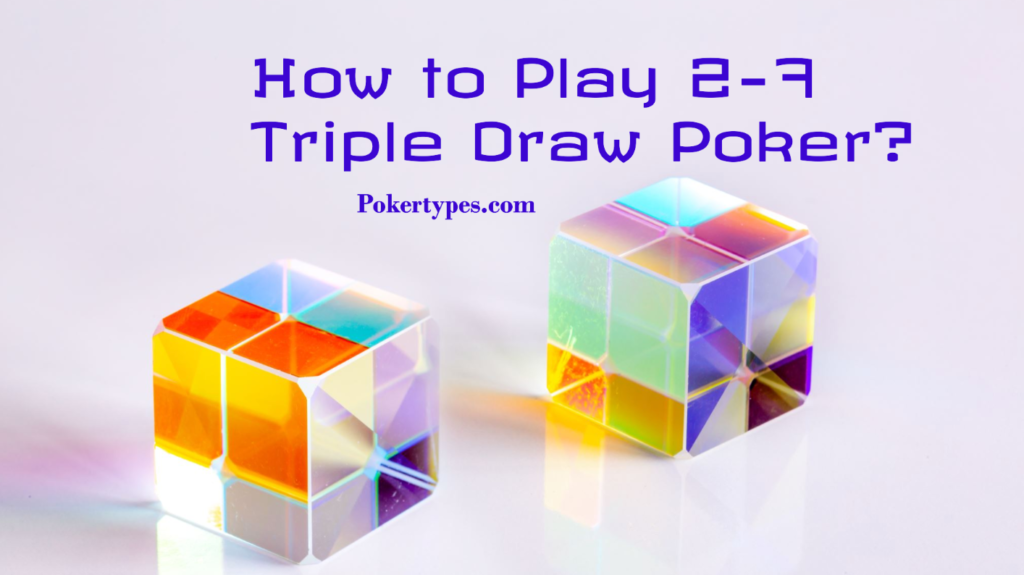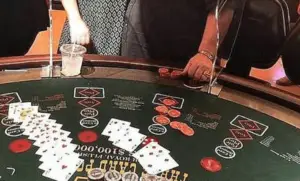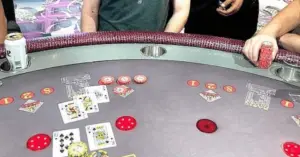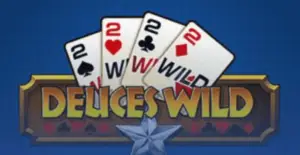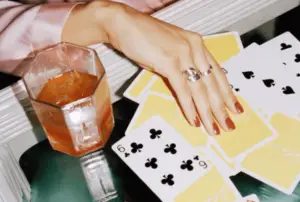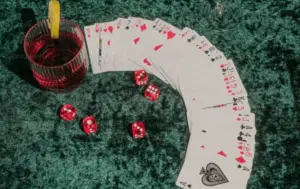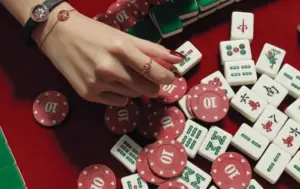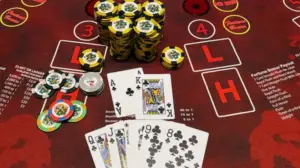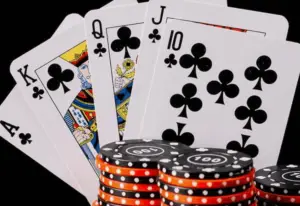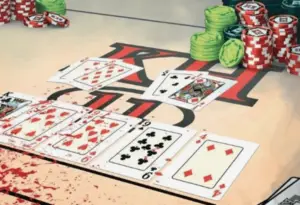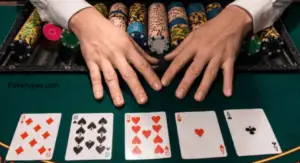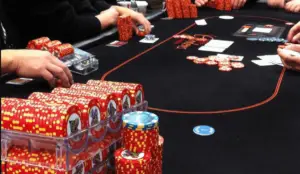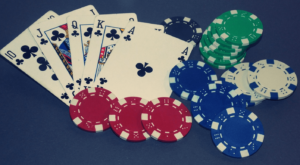2-7 Triple Draw Poker is a unique and exciting lowball draw variant that challenges players to make the lowest possible five-card hand.
Unlike traditional poker games, the goal in 2-7 Triple Draw is to aim for cards ranked 7 or lower, with no flushes or straights. The best possible hand, known as “The Wheel,” is 7-5-4-3-2.
What sets this game apart are the three drawing rounds that allow players to discard and replace cards, adding an extra layer of strategy.
With aces always ranking high and flushes, pairs, and straights working against you, 2-7 Triple Draw Poker offers a fresh twist on classic poker gameplay.
Typically played with a fixed-limit betting structure and a maximum of six players, this engaging variant is a favorite among poker enthusiasts looking for a new challenge.
The Basics of 2-7 Triple Draw
In 2-7 Triple Draw, the objective is to make the lowest possible five-card hand using unique hand rankings.
Unlike traditional poker games, aces are always high, and straights and flushes actually count against you. This means that hands like A-2-3-4-5 or 2-3-4-5-6 are not considered strong in this variant.
The best possible hand in 2-7 Triple Draw is known as “The Wheel” or “Number One,” which consists of a 7-5-4-3-2 offsuit. Other strong hands include 7-6-4-3-2, 7-6-5-3-2, and 7-6-5-4-2.
Hands with no pairs, straights, or flushes are called “perfect” or “smooth” hands, while those with one of these undesirable features are referred to as “rough” hands.
The game is typically played with a fixed limit betting structure and a maximum of six players at the table.
The betting rounds follow a similar pattern to Texas Hold’em, with small and big blinds posted before the deal, and four rounds of betting: pre-draw, after the first draw, after the second draw, and after the third draw.
One of the key strategies in 2-7 Triple Draw is knowing when to “break” your hand and draw for a better one.
For example, if you have a rough hand like 8-7-6-5-2 with a straight draw, it might be wise to break the hand and draw for a smooth one, even if it means giving up the low 8. On the other hand, if you already have a strong smooth hand like 7-6-4-3-2, you may choose to “stand pat” and not draw any cards.
Another important aspect of the game is position. Being in a late position allows you to observe your opponents’ actions and make more informed decisions about your own hand.
If you’re in an early position with a marginal hand, it’s often best to fold and wait for a better opportunity. Bluffing can also be a powerful tool in 2-7 Triple Draw, especially if you’re in a late position and your opponents have shown weakness by drawing multiple cards.
How to Play 2-7 Triple Draw?
Blinds and Deal
In 2-7 Triple Draw, the game begins with the posting of blinds, just like in Texas Hold’em. The player to the left of the dealer posts the small blind, and the next player posts the big blind. Once the blinds are in place, each player receives five cards face down.
First Betting Round
After the initial deal, the first betting round, known as the “pre-draw” round, begins. The action starts with the player to the left of the big blind, who can choose to call, raise, or fold. Betting continues clockwise around the table until all active players have placed equal bets.
First Drawing Round
Once the first betting round concludes, players enter the first drawing round. Starting with the player to the left of the dealer, each active player can discard any number of cards (0-5) and receive new ones from the deck.
If a player discards all five cards, they are dealt four cards first, followed by a single card after everyone else has received their cards to prevent potential cheating.
Second Betting Round
After the first draw, another betting round takes place, starting with the first active player to the left of the dealer. Players can check, bet, call, raise, or fold based on the strength of their updated hands.
Second Drawing Round
The second drawing round follows the same process as the first, with players discarding and receiving new cards to improve their hands.
Third Betting Round
Once the second drawing round is complete, players enter the third betting round, following the same rules as the previous betting rounds.
Third Drawing Round
In the final drawing round, players have one last chance to improve their hands by discarding and receiving new cards.
Final Betting Round
The last betting round, known as the “post-draw” round, occurs after the third drawing round. Players make their final bets based on the strength of their completed hands.
Showdown
If more than one player remains after the final betting round, the game proceeds to a showdown. The player with the lowest hand according to the 2-7 Triple Draw hand rankings wins the pot. In 2-7 Triple Draw, the best possible hand is 7-5-4-3- (known as “The Wheel” or “Number One“), with no flushes or straights. Aces are always high, so hands like A-2-3-4-5 are not considered strong.
Throughout the game, players must make strategic decisions based on the strength of their starting hands, the number of cards they need to draw, and their position at the table. Bluffing and semi-bluffing can also be effective tactics, especially when combined with a good understanding of opponent tendencies and betting patterns.
2-7 Triple Draw Hand Rankings
In 2-7 Triple Draw, the objective is to make the lowest possible five-card hand using a unique hand ranking system. The best possible hand, known as “The Wheel” or “Number One,” is 7-5-4-3-2 offsuit. This hand is considered the “nuts” in the 2-7 Triple Draw. Other strong hands include:
7-6-4-3-2 (unsuited)
7-6-5-3-2 (unsuited)
7-6-5-4-2 (unsuited)
These hands are ranked based on their highest card, followed by the second highest, and so on. Hands in 2-7 Triple Draw can be categorized as either “perfect” (also called “smooth“) or “rough.” A perfect or smooth hand contains no pairs, straights, or flushes, while a rough hand contains at least one of these undesirable features. Here are some examples of hands and how they rank:
7-5-4-3-2 (unsuited) – The Wheel, the best possible hand
7-6-4-3-2 (unsuited) – Second-best hand
7-6-5-3-2 (unsuited) – Third-best hand
7-6-5-4-3 (unsuited) – Strong smooth hand
8-6-4-3-2 (unsuited) – Strong smooth hand, but ranked lower due to the 8
7-7-5-4-3 (one pair) – Rough hand, ranked lower than smooth hands
8-7-6-5-4 (straight) – Rough hand, ranked lower than non-straight hands
K-Q-J-9-8 (unsuited) – Very weak hand, all high cards
In 2-7 Triple Draw, aces are always considered high cards, so a hand like A-2-3-4-5 is actually a very poor hand. Interestingly, the hand rankings in 2-7 Triple Draw follow the tetrahedral number sequence: 1, 4, 10, 20, 35, 56, etc. The formula for the nth number in this sequence is 2 times the previous number minus the number before that.
2-7 Triple Draw Winning Strategies
To excel at 2-7 Triple Draw, you need a solid grasp of starting hand selection, drawing strategy, betting and bluffing tactics, and positional awareness. Let’s dive into each of these key aspects:
Starting Hand Selection
In 2-7 Triple Draw, your starting hand selection is crucial. You want hands that have the potential to become strong, smooth low hands with minimal drawing. Some examples of good starting hands include:
7-6-4-3-X (unsuited)
7-5-4-X-X (unsuited)
7-6-5-X-X (unsuited)
Avoid starting hands with high cards or multiple cards of the same suit, as they can easily turn into straights or flushes, which are undesirable in this game.
Drawing Strategy: When to Break Hands and Draw
Knowing when to “break” your hand and draw for a better one is a key skill in 2-7 Triple Draw. If you have a rough hand with a pair or a straight draw, it’s often best to break it and draw for a smooth hand, even if it means giving up a low card.
For example, if you have 8-7-6-5-2 with a straight draw, consider breaking the hand and drawing for a smooth 7-low or 8-low. On the other hand, if you have a strong smooth hand like 7-6-4-3-2, you may choose to “stand pat” and not draw any cards. As a general rule, avoid drawing more than three cards, as this often indicates a weak hand to your opponents.
Betting and Bluffing Tactics
Betting and bluffing are essential aspects of 2-7 Triple Draw strategy. Bet aggressively with strong draws or made hands to build the pot and force opponents to fold. If you’re in a late position and your opponents have shown weakness by drawing multiple cards, consider bluffing to represent a strong hand.
However, be cautious when bluffing, as the multiple drawing rounds can give your opponents a chance to improve their hands. Balance your bluffing frequency to avoid becoming predictable.
Positional Awareness and Opponent Reading
The position is a critical factor in 2-7 Triple Draw. Being in a late position allows you to observe your opponents’ actions and make more informed decisions. If you’re in an early position with a marginal hand, it’s often best to fold and wait for a better opportunity.
Pay close attention to your opponents’ drawing habits and betting patterns. If an opponent consistently draws one or two cards and then bets aggressively, they likely have a strong hand. Conversely, if an opponent frequently draws three or more cards, they may be chasing a draw or holding a weak hand.
Tips for Success in 2-7 Triple Draw
To become a winning player in 2-7 Triple Draw, it’s essential to follow these key strategies:
Play Strong Starting Hands in Early Position
When you’re in an early position, it’s crucial to be selective with your starting hands. Look for hands that have the potential to become strong, smooth low hands with minimal drawing, such as 7-6-4-3-X or 7-5-4-X-X (unsuited). By playing tight in an early position, you avoid getting involved in marginal situations and can save your chips for better opportunities.
Draw to the Best Possible Hand
In 2-7 Triple Draw, your goal is to make the lowest possible five-card hand. When deciding which cards to discard, always aim for the strongest potential hand.
For example, if you have 8-7-6-5-2 with a straight draw, consider breaking the hand and drawing for a smooth 7-low or 8-low. Don’t be afraid to break pairs or discard low cards if it means you can draw to a stronger hand.
Bet Aggressively with Strong Draws and Made Hands
When you have a strong draw or a made hand, it’s time to put pressure on your opponents by betting aggressively. This serves two purposes: it builds the pot when you have a strong hand, and it forces your opponents to make difficult decisions.
If you’re in a late position and your opponents have shown weakness by drawing multiple cards, consider bluffing to represent a strong hand and take down the pot.
Adapt to Your Opponents’ Playing Styles
Pay close attention to your opponents’ tendencies and adjust your strategy accordingly. If an opponent is playing very tight, you can exploit them by bluffing more often or playing more marginal hands.
Conversely, if an opponent is playing aggressively and frequently bluffing, you can adjust by calling more often with your strong hands and letting them bluff off their chips. Here are some additional tips to keep in mind:
Avoid playing too many hands out of position, as it puts you at a significant disadvantage.
Be cautious with rough hands, especially those containing a 6, as they can easily turn into straights or pairs.
Don’t overvalue high cards like J-10-9-8 or Q-10-7-5, as they are unlikely to improve to a strong hand even with multiple draws.
Pay attention to your opponents’ drawing habits. If they consistently draw one or two cards, they likely have a strong hand. If they frequently draw three or more cards, they may be chasing a draw or holding a weak hand.
2-7 Triple Draw Variations and History
2-7 Triple Draw is a popular lowball draw variant, but there are other formats like Single Draw and different betting structures such as Fixed Limit and No Limit.
In Single Draw, players only have one drawing round instead of three, making for a faster-paced game.
The most common form of 2-7 Triple Draw uses the Fixed Limit betting format, where players have two bet sizes: a small bet and a big bet.
However, No Limit 2-7 Single Draw is also played, particularly in high-stakes cash games and tournaments.
The World Series of Poker (WSOP) has featured several 2-7 Triple Draw events over the years, attracting top professionals and enthusiasts alike. In 2024, the $10,000 Limit 2-7 Lowball Triple Draw Championship drew 149 entrants, generating a prize pool of $1,385,700.
The event was won by Peter Gelencser from Hungary, who took home $180,730.Another notable WSOP event in 2024 was the $10,000 No-Limit 2-7 Lowball Draw Championship, which saw Scott Seiver capture his third bracelet of the series.
This marked the first time since Jeff Lisandro‘s feat in 2009 that a player won three bracelets in a single WSOP year.
These events showcase the enduring popularity and challenge of 2-7 Triple Draw and its variations, attracting skilled players from around the world who compete for prestige and substantial prize pools.
Conclusion
2-7 Triple Draw stands out as a unique and challenging poker variant that tests players’ skills in hand selection, drawing strategy, and betting.
Mastering this game requires a deep understanding of the reversed hand rankings, where the lowest hand, such as 7-5-4-3-2, is the nuts.
By carefully choosing when to “break” hands and draw for better ones, betting aggressively with strong draws and made hands, and adapting to opponents’ playing styles, players can excel at this exciting format.
With practice and dedication, anyone can become a skilled 2-7 Triple Draw player and enjoy the thrill of this distinctive poker game.
